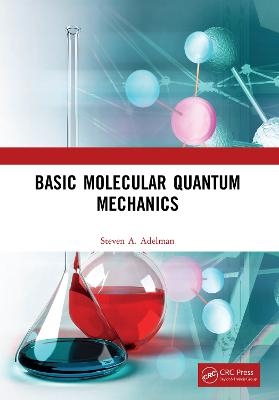
Basic Molecular Quantum Mechanics
Crc Press Inc (Verlag)
978-1-4987-3399-1 (ISBN)
Quantum mechanics is a general theory of the motions, structures, properties, and behaviors of particles of atomic and subatomic dimensions. While quantum mechanics was created in the first third of the twentieth century by a handful of theoretical physicists working on a limited number of problems, it has further developed and is now applied by a great number of people working on a vast range of problems in wide areas of science and technology.
Basic Molecular Quantum Mechanics introduces quantum mechanics by covering the fundamentals of quantum mechanics and some of its most important chemical applications: vibrational and rotational spectroscopy and electronic structure of atoms and molecules. Thoughtfully organized, the author builds up quantum mechanics systematically with each chapter preparing the student for the more advanced chapters and complex applications. Additional features include the following:
This book presents rigorous and precise explanations of quantum mechanics and mathematical proofs.
It contains qualitative discussions of key concepts with mathematics presented in the appendices.
It provides problems and solutions at the end of each chapter to encourage understanding and application.
This book is carefully written to emphasize its applications to chemistry and is a valuable resource for advanced undergraduates and beginning graduate students specializing in chemistry, in related fields such as chemical engineering and materials science, and in some areas of biology.
Steven. A. Adelman (Steve) was born and grew up on the West Side of Chicago. He developed a passion for science in early childhood becoming especially fascinated by human evolution. Gradually his interests shifted to Chemistry, Physics, and Mathematics. Thus, he was led to obtain a Ph.D. in 1972 from Harvard University in Theoretical Chemical Physics, the branch of chemistry most closely aligned with physics and mathematics. In his Ph.D. thesis he treated several problems in atomic and molecular physics. He chose as his thesis advisor future Chemistry Nobel Laureate Dudley R. Herschbach whose imaginative reactive molecular beam scattering experiments helped found the parent field of gas phase chemical reaction dynamics, a field which revolutionized the traditional field of chemical kinetics. After receiving his Ph.D. Steve took post-doctoral fellowships first at MIT and then at the University of Chicago to learn statistical mechanics, the area of theoretical physics concerned with statistical determinations of the equilibrium and non-equilibrium behaviors of systems with many particles. He joined Purdue University as an Assistant Professor in 1975, became a full Professor in 1981, and is now Professor Emeritus of Chemistry. His current research deals with using a novel reformulation of the statistical mechanical theory of irreversible processes to generalize the parent field of gas phase chemical reaction dynamics to the much more complex and broadly impactful daughter field of condensed matter chemical reaction dynamics, especially reaction dynamics occurring on solid surfaces and in liquid solutions. For this work Steve has garnered thousands of citations and many speaker invitations, including keynote speaker invitations, at meetings in several fields world-wide. Adelman has been awarded both Alfred P. Sloan and John Simon Guggenheim Memorial fellowships. He is a fellow of both the American Physical Society and the American Association for the Advancement of Science. He has been listed in Marquis’ Who’s who in America every year since 1985 and has been listed four times in Marquis’ Who’s who in the world.
Chapter 1 Toward Quantum Mechanics Chapter 2 Mathematics for Quantum Mechanics Chapter 3 The Schrodinger Equation and the Particle-in-a-Box Chapter 4 Wave Functions and Experimental Outcomes Chapter 5 Commutation Rules and Uncertainty Relations Chapter 6 Stationary and Non-stationary Quantum States Chapter 7 The Harmonic Oscillator Chapter 8 Rigid Rotations and Rotational Angular Momentum Chapter 9 Diatomic Rotational–Vibrational Spectroscopy Chapter 10 The Hydrogen-Like Atoms Chapter 11 Approximation Methods Chapter 12 Electrons in Atoms Chapter 13 Molecular Electronic Structure and Chemical Bonding
| Erscheinungsdatum | 03.08.2021 |
|---|---|
| Zusatzinfo | 45 Tables, black and white; 1 Line drawings, color; 114 Line drawings, black and white; 1 Illustrations, color; 114 Illustrations, black and white |
| Verlagsort | Bosa Roca |
| Sprache | englisch |
| Maße | 178 x 254 mm |
| Gewicht | 948 g |
| Themenwelt | Naturwissenschaften ► Biologie ► Genetik / Molekularbiologie |
| Naturwissenschaften ► Chemie ► Physikalische Chemie | |
| Naturwissenschaften ► Physik / Astronomie ► Angewandte Physik | |
| ISBN-10 | 1-4987-3399-9 / 1498733999 |
| ISBN-13 | 978-1-4987-3399-1 / 9781498733991 |
| Zustand | Neuware |
| Haben Sie eine Frage zum Produkt? |
aus dem Bereich


